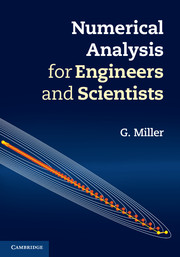Refine listing
Actions for selected content:
1372 results in Ebooks on robotics
Acknowledgments
-
- Book:
- The Cambridge Handbook of Artificial Intelligence
- Published online:
- 05 July 2014
- Print publication:
- 12 June 2014, pp xii-xii
-
- Chapter
- Export citation
Index
-
- Book:
- The Cambridge Handbook of Artificial Intelligence
- Published online:
- 05 July 2014
- Print publication:
- 12 June 2014, pp 343-354
-
- Chapter
- Export citation
11 - Actions and agents
-
-
- Book:
- The Cambridge Handbook of Artificial Intelligence
- Published online:
- 05 July 2014
- Print publication:
- 12 June 2014, pp 232-246
-
- Chapter
- Export citation

Relay Autotuning for Identification and Control
-
- Published online:
- 05 June 2014
- Print publication:
- 15 May 2014

Numerical Methods in Engineering with Python 3
-
- Published online:
- 05 June 2014
- Print publication:
- 21 January 2013

Numerical Analysis for Engineers and Scientists
-
- Published online:
- 05 June 2014
- Print publication:
- 29 May 2014

Mobile Robotics
- Mathematics, Models, and Methods
-
- Published online:
- 05 June 2014
- Print publication:
- 11 November 2013
5 - Interpolation
-
- Book:
- Numerical Analysis for Engineers and Scientists
- Published online:
- 05 June 2014
- Print publication:
- 29 May 2014, pp 125-152
-
- Chapter
- Export citation
2 - Direct solution of linear systems
-
- Book:
- Numerical Analysis for Engineers and Scientists
- Published online:
- 05 June 2014
- Print publication:
- 29 May 2014, pp 22-55
-
- Chapter
- Export citation
6 - Iterative methods and the roots of polynomials
-
- Book:
- Numerical Analysis for Engineers and Scientists
- Published online:
- 05 June 2014
- Print publication:
- 29 May 2014, pp 153-181
-
- Chapter
- Export citation
Frontmatter
-
- Book:
- Numerical Analysis for Engineers and Scientists
- Published online:
- 05 June 2014
- Print publication:
- 29 May 2014, pp i-iv
-
- Chapter
- Export citation
1 - Numerical error
-
- Book:
- Numerical Analysis for Engineers and Scientists
- Published online:
- 05 June 2014
- Print publication:
- 29 May 2014, pp 1-21
-
- Chapter
- Export citation
8 - Data fitting
-
- Book:
- Numerical Analysis for Engineers and Scientists
- Published online:
- 05 June 2014
- Print publication:
- 29 May 2014, pp 213-242
-
- Chapter
- Export citation
11 - Introduction to stochastic ODEs
-
- Book:
- Numerical Analysis for Engineers and Scientists
- Published online:
- 05 June 2014
- Print publication:
- 29 May 2014, pp 302-325
-
- Chapter
- Export citation
4 - Iterative approaches for linear systems
-
- Book:
- Numerical Analysis for Engineers and Scientists
- Published online:
- 05 June 2014
- Print publication:
- 29 May 2014, pp 93-124
-
- Chapter
- Export citation
Index
-
- Book:
- Numerical Analysis for Engineers and Scientists
- Published online:
- 05 June 2014
- Print publication:
- 29 May 2014, pp 567-572
-
- Chapter
- Export citation
12 - A big integrative example
-
- Book:
- Numerical Analysis for Engineers and Scientists
- Published online:
- 05 June 2014
- Print publication:
- 29 May 2014, pp 326-352
-
- Chapter
- Export citation
Appendix B - Sample codes
-
- Book:
- Numerical Analysis for Engineers and Scientists
- Published online:
- 05 June 2014
- Print publication:
- 29 May 2014, pp 371-453
-
- Chapter
- Export citation
Solutions
-
- Book:
- Numerical Analysis for Engineers and Scientists
- Published online:
- 05 June 2014
- Print publication:
- 29 May 2014, pp 454-554
-
- Chapter
- Export citation
3 - Eigenvalues and eigenvectors
-
- Book:
- Numerical Analysis for Engineers and Scientists
- Published online:
- 05 June 2014
- Print publication:
- 29 May 2014, pp 56-92
-
- Chapter
- Export citation
